
views
Boiling Quail Eggs
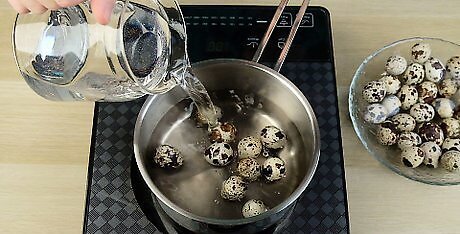
Place the quail eggs into a pot of cold water. Preparing boiled quail eggs is similar to making hard-boiled eggs. First, lay out all the eggs you’re boiling in a pot. Then pour in cold water until the eggs are just covered. Since quail eggs are so small, using a pan instead of a pot will make the water boil faster. Just make sure the water covers the eggs entirely.

Bring the water to a boil. Place the pot or pan on a stovetop and start a high flame. Wait until the water boils and then bring it down to a simmer.

Cook the eggs for 2 minutes. Once the water boils, start timing. Turn the flame off 2 minutes after the water boiled. Cooking the eggs for 2 minutes gives you an egg with a runny yolk. If you prefer a solid yolk, cook the eggs for 3 minutes instead.

Transfer the eggs to an ice bath with a slotted spoon. Dip a slotted spoon into the water and fish out each egg. Place it in a bowl of water filled with ice to cool it off enough to handle. Leave the eggs in the bath for 1 minute and then check if they’re cool enough. Wait longer if they’re still hot. Don’t reach into the boiling water or you will burn yourself. The ice bath also makes the shells come off easier when you peel the eggs.

Roll the eggs gently to crack their shells. Peeling a quail egg is similar to peeling a chicken egg, but the quail egg is much smaller and more fragile. Tap each egg on something hard to crack the shell. Then roll the egg on a flat surface so the rest of the shell cracks. Don’t apply too much pressure while rolling the egg or you’ll crush it. Just roll lightly. Put down a paper towel to catch any shell bits that fall off.
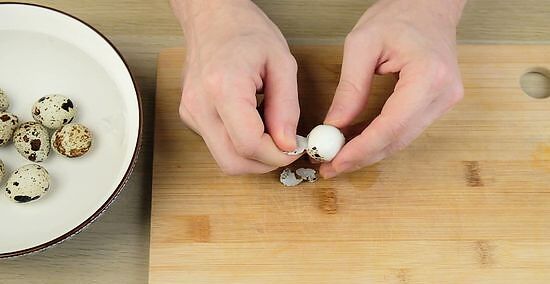
Peel the shell and membrane off. Once the eggs are cracked, the shells should come off easily. Carefully peel the bits of shell and membrane off. Don't press down or squeeze when you remove the shell to avoid crushing the egg. Remember to peel off the clear membrane between the shell and the egg as well. If the shells aren’t coming off, put the eggs back in the ice bath for another minute. Then try to peel them again.

Serve the eggs plain, on toast, or in a salad. Once you’ve peeled the eggs, there are many ways to serve them. Pop them in your mouth whole for a quick snack. For a classic breakfast, put the eggs on a piece of toast with salt and pepper. Sliced up quail eggs also work as a great salad topping. Use a very thin knife to slice the eggs. If you don’t have a thin knife, try using a strip of dental floss to slice them. If you like spice, add some powdered cayenne pepper. Boiled eggs can last up to a week in the refrigerator. You can also pickle the eggs by soaking them in vinegar.
Frying the Eggs
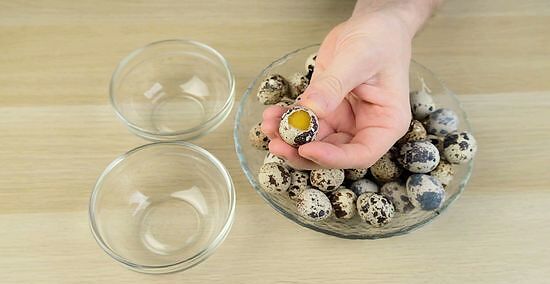
Remove the top of the eggshell with a sharp knife. Cracking quail eggs is difficult because they’re so small. To get the contents out without breaking the yolk, hold the egg firmly in one hand. Then take a small, sharp knife and make an incision 1/4 of the way down from the top. Cut around the egg until the top section pops off. Be very careful not to cut yourself on this step. Keep your fingers away from the blade. Pay attention to what you’re doing to avoid slipping.

Pour the eggs out into a bowl. With the top detached from the egg, simply turn the egg upside down over a bowl to empty the contents. The white and yolk will come out together. Pour out all the eggs that you’re cooking. If you want your eggs scrambled, scramble them now with a spoon. If you don’t want the eggs to cook together, pour each one into its own cup. Alternatively, pour the egg directly from the shell to the pan.
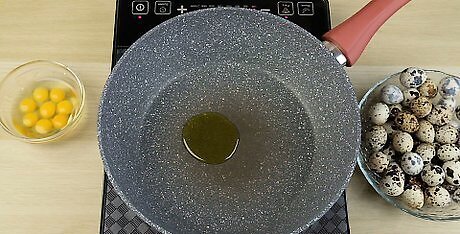
Heat 2 US tbsp (30 ml) of olive oil in a non-stick pan. Pour the oil into a pan and turn on a medium flame. Let the oil heat up for 1 minute before you start cooking the eggs. Start cooking before the oil starts smoking. If you see smoke rising from the oil, turn the heat down.

Pour the eggs into the pan and cook them for 1 minute. Once the oil is hot enough, transfer the eggs to the pan. They’ll start sizzling right away. Leave them on for 1 minute for a fried egg with a runny yolk. If you prefer your eggs over easy, flip them with a spatula and cook for another minute on the other side. For scrambled eggs, let them cook for 1 minute as well. If the eggs look too runny for you, let them cook another 30-60 seconds.
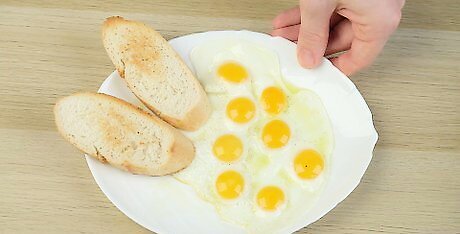
Remove the eggs and serve them on toast or a bun. Once the eggs are cooked, remove them from the pan and transfer them to a plate. They make an excellent breakfast if you pair them with toast, just like normal fried eggs. You can also top bruschetta with them. Sprinkle salt and pepper over the eggs for more flavor. A fried quail egg also works well as a topping. Try putting one on top of a hamburger or crab cake for added flavor and protein. Fried eggs will last only a few hours in the refrigerator. Use them as soon as possible.
Poaching Quail Eggs

Fill a small pot with water and add ⁄4 cup (59 ml) of white vinegar. The vinegar helps keep the egg whites intact while they poach. Add the vinegar and stir the mixture. Since quail eggs are so small, a small pot works in most situations. For a large batch of over 12 eggs, use a larger pot like you would for poaching regular eggs.

Cut the top off of the eggshell with a sharp knife. This is the best method of getting the egg contents out without breaking the yolk. Use a small, sharp knife and make an incision 1/4 of the way down from the top of the eggshell. Cut around the egg until the top section pops off. Be very careful during this step. Keep your fingers away from the knife blade.

Pour the egg contents into a bowl. Once the shell top is off, turn the egg upside down over a bowl so the white and yolk come out. Don’t worry about the eggs being stuck together. The poaching process separates them. If the yolk won't come out, use the knife to widen the hole.

Bring the water to a boil. Place the pot on a stovetop and turn on a high flame. Wait for bubbles to start rising up, indicating that the water is boiling. Then lower the flame and let the water simmer.

Pour the eggs into the pot and cook them for 2 minutes. Once you pour the eggs in, they’ll make what looks like a white cloud. This is normal and means the eggs are cooking. Let them simmer for 2 minutes so they cook all the way through. If you want the egg yolks more solid, leave them in for 3 minutes instead of 2.
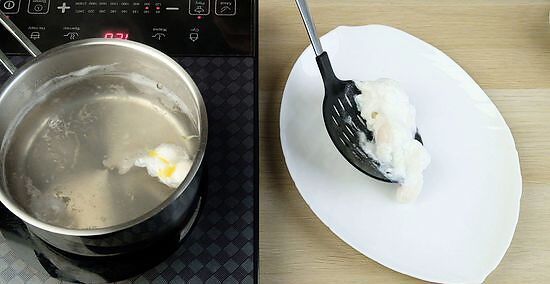
Remove the eggs with a skimmer or slotted spoon. After 2 minutes, the eggs are fully poached. Dip a slotted spoon or skimmer into the water and take each egg out. Transfer them to a plate so they cool off. Count the number of eggs you remove to make sure you got them all. The remaining egg whites left in the water might make it hard to see. If you’d like a nicer presentation, trim away the excess egg white around each yolk with a knife. This isn't necessary because the whole egg is edible.

Serve the eggs with toast, salad, or other small plates. Poached quail eggs go with many meals. You can put them on toast for a classic breakfast item. Slice them up and use them as a salad topping. Additionally, many appetizer and finger food items like bruschetta pair well with quail eggs. Add some salt or pepper for flavor. Try sprinkling some powdered cayenne pepper for extra spice. Poached eggs will last only a few hours in the refrigerator. Use them as soon as possible.










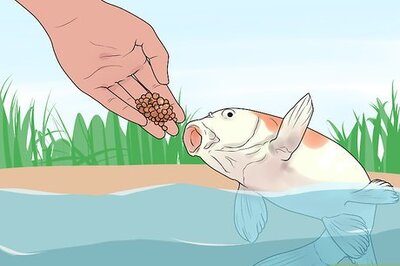



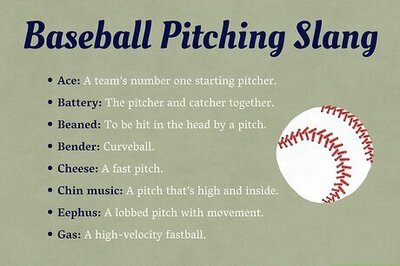

Comments
0 comment